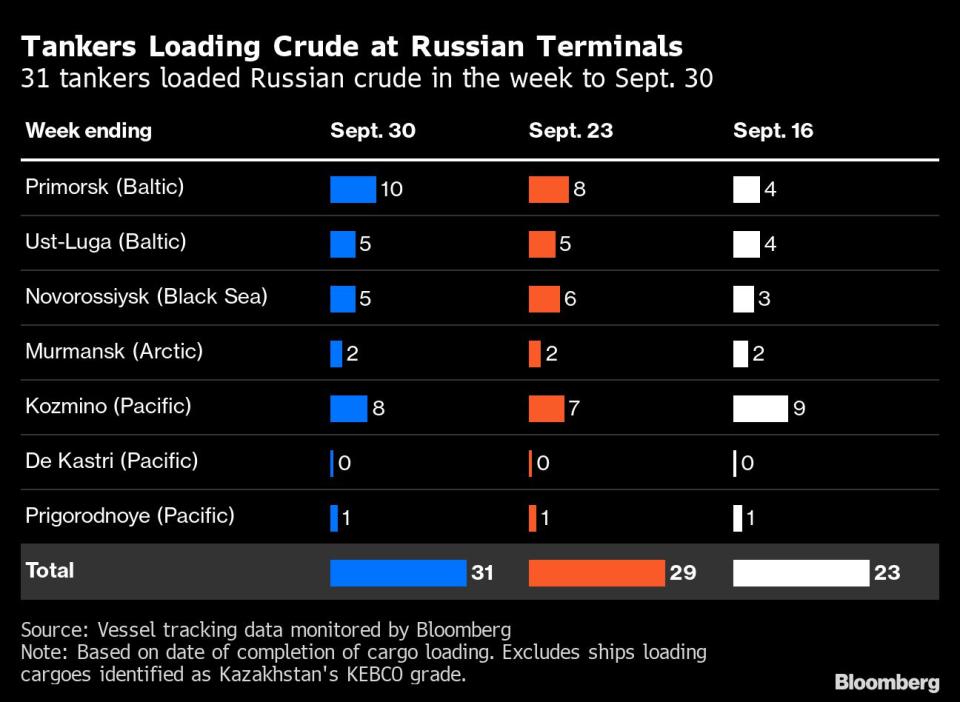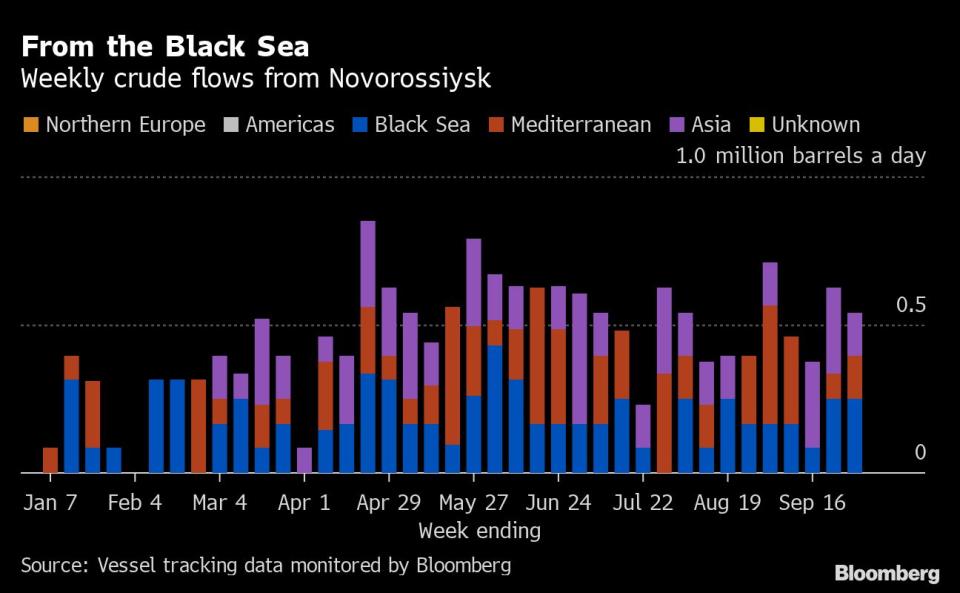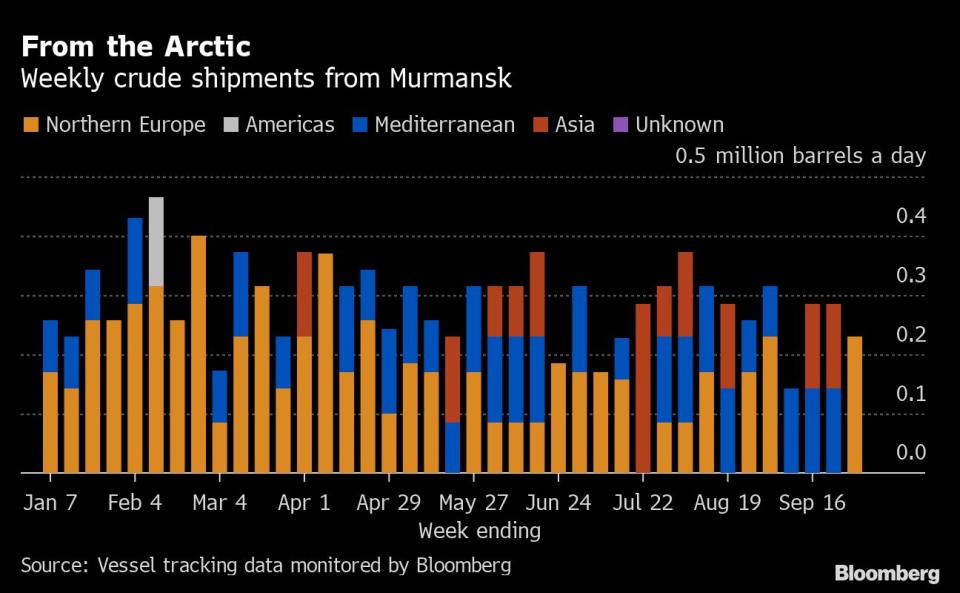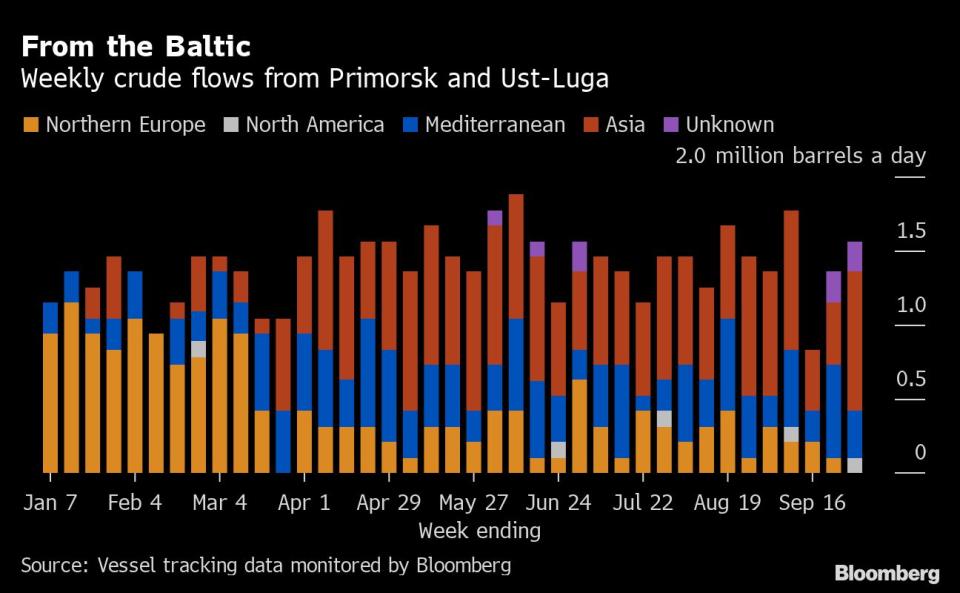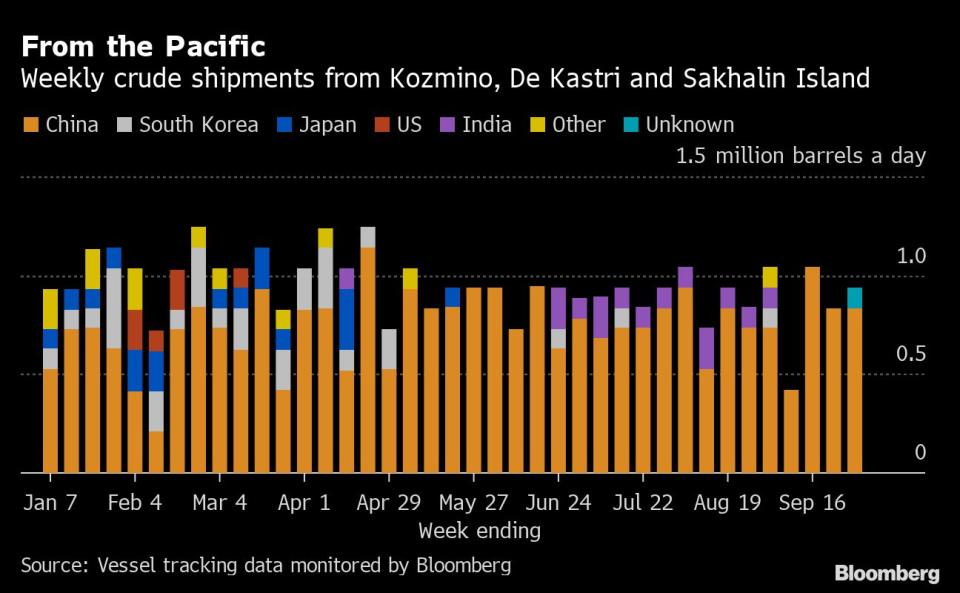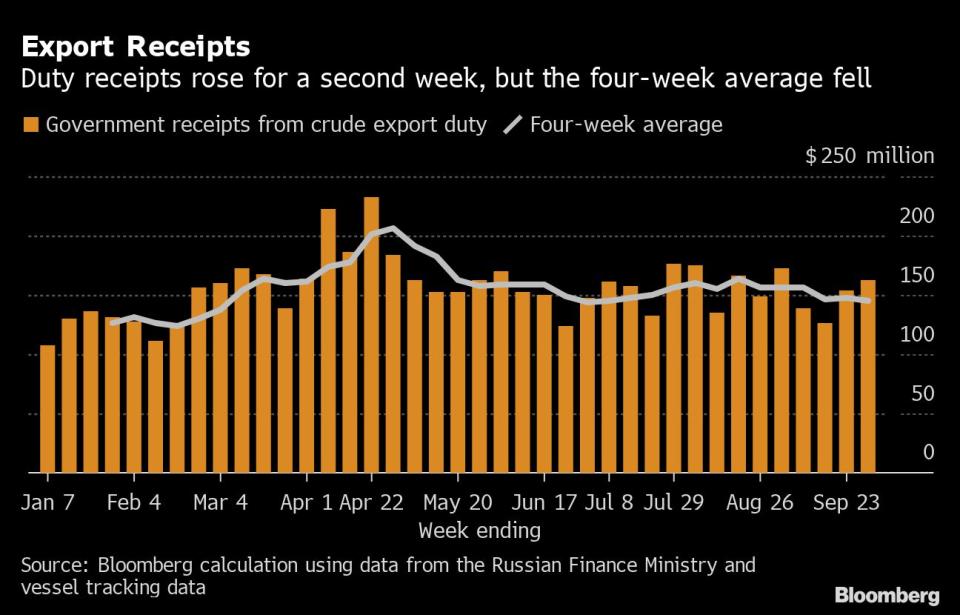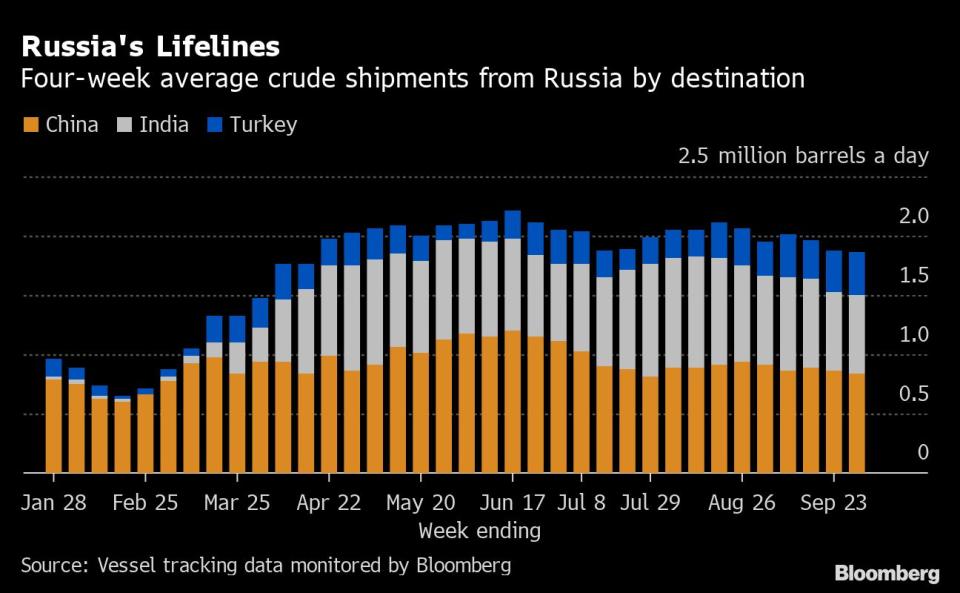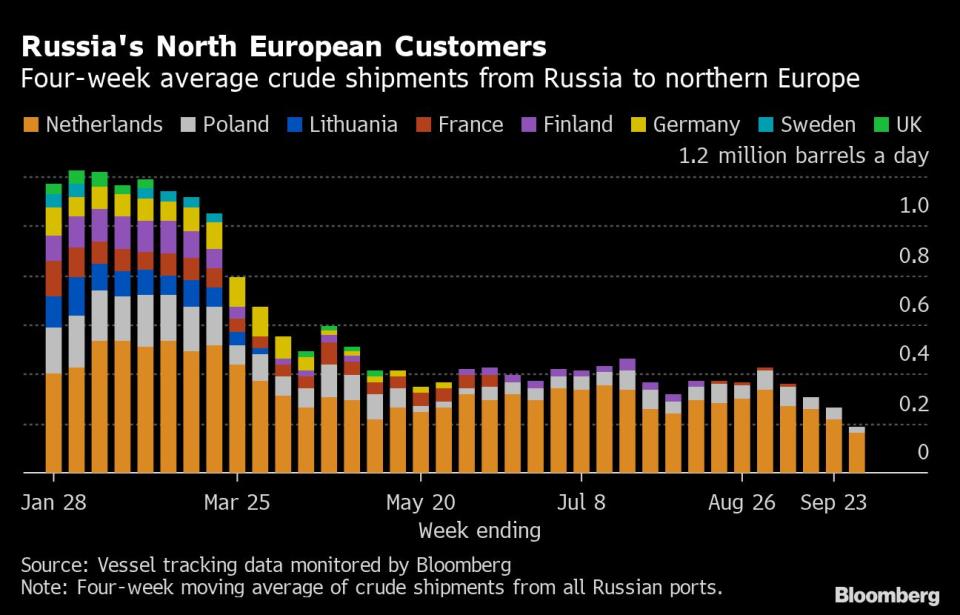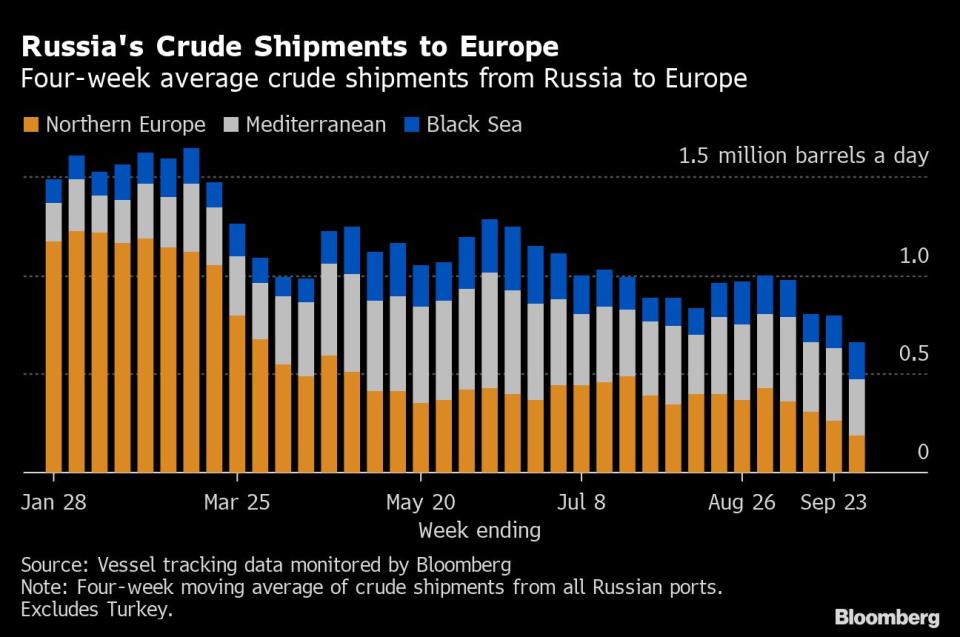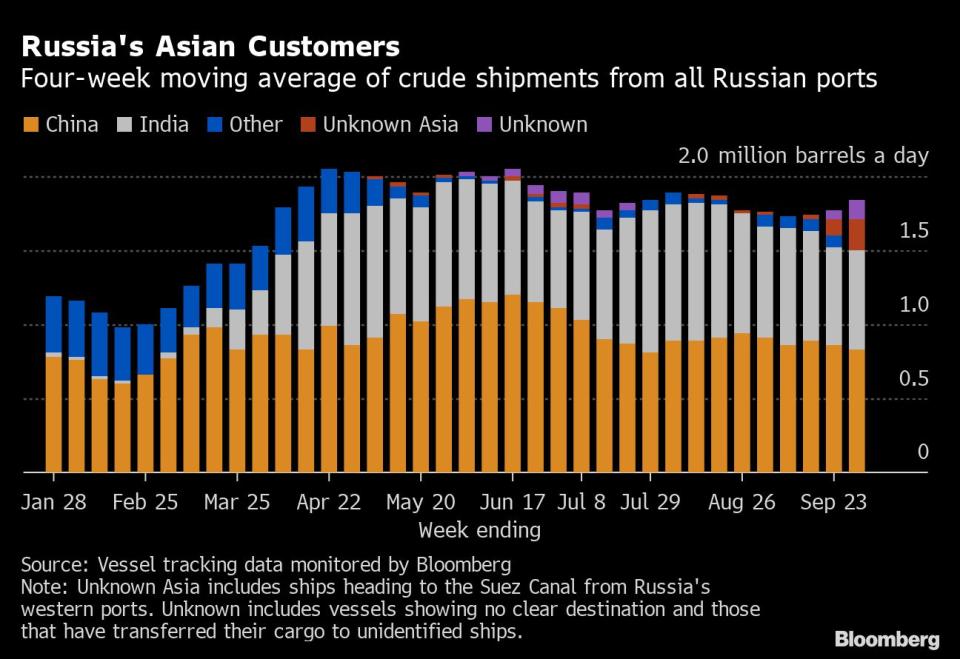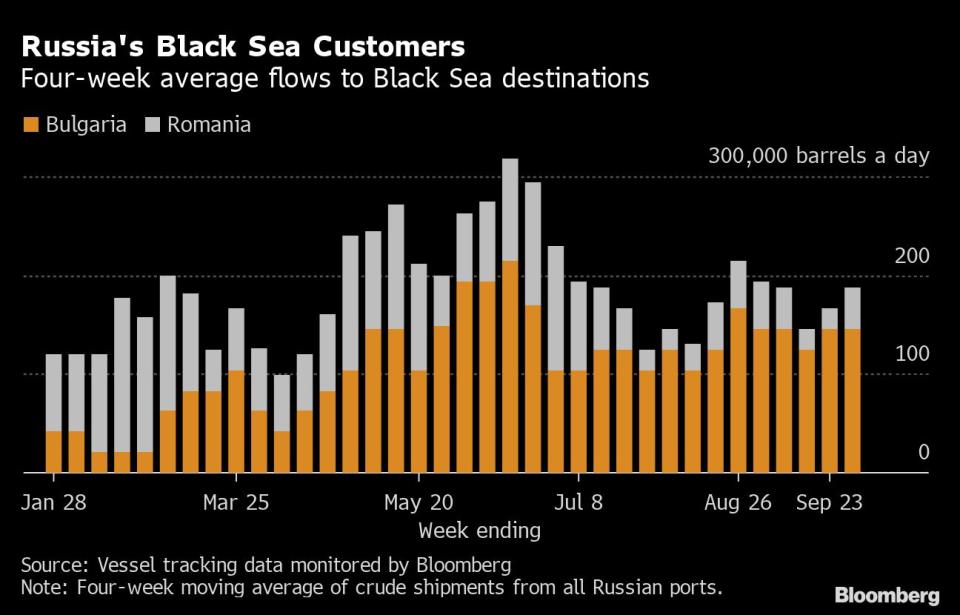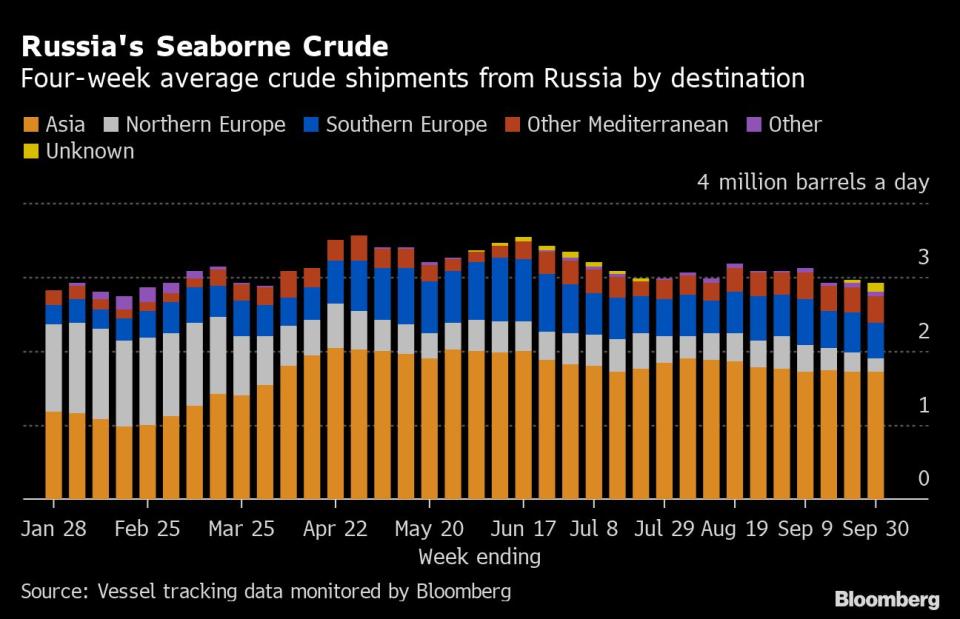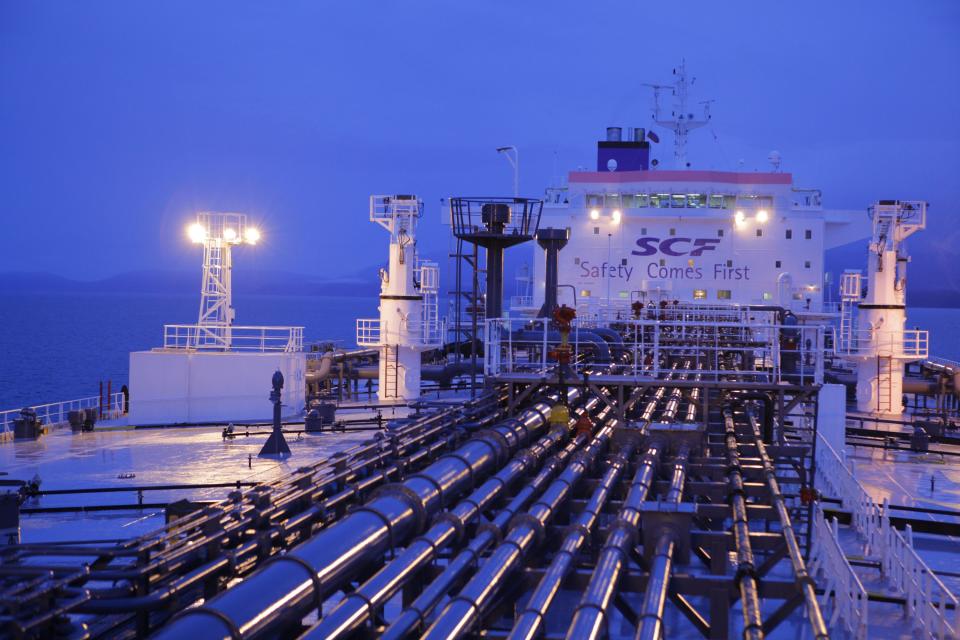Europe Turns Its Back on Russian Crude as Sanctions Draw Closer
(Bloomberg) -- The European market for Russia’s seaborne crude is drying up as sanctions draw nearer, and the country’s Asian customers aren’t picking up the slack like they once were.
Most Read from Bloomberg
Stocks Rise From the Ashes in Best Day Since July: Markets Wrap
Elon Musk Sets Off Uproar in Ukraine by Tweeting His ‘Peace’ Plan
North Korea Fires Missile Over Japan for First Time Since 2017
With just over two months until a European Union ban on seaborne crude imports comes into effect, shipments to the bloc plus the UK are down by about 60% from where they were before Moscow’s troops invaded Ukraine.
Customers in northern Europe in particular have slashed their purchases, which are now running below 200,000 barrels a day, down by 1 million from the levels seen at the start of the year.
Meanwhile the diversion of crude flows from Europe to Asia appears to have reached a plateau. Flows to the big three buyers of Russian barrels — China, India and Turkey — which initially stepped in to fill the gap after European buyers started to shun Moscow’s exports, peaked in June at 2.2 million barrels a day. In the four weeks to Sept. 30 that figure was down by about 350,000 barrels a day.
While the volume on tankers yet to show final destinations may narrow that gap, it won’t eliminate it completely.
While total crude flows shipped out of Russia in the week to Sept. 30 edged higher, the four-week average, which smooths out some of the noise in the data, moved in the opposite direction.
A US plan to impose a price cap that would see purchasers granted access to insurance and other essential services only if the price paid is below a yet-to-be-determined threshold, is creating confusion among buyers. Lack of clarity over the level at which the cap will be set, uncertainty over when it will be implemented, and few details on how it will be policed, are leaving would-be purchasers of Russian crude in limbo until the situation is clarified.
Even though Russia has said it won’t sell its oil to anyone who imposes a price cap and its major customers remain unlikely to endorse the plan, the existence of such a mechanism may boost the bargaining power key customers China, India and Turkey have over Russia for future purchases.
On top of this, Russia’s revenues face another headwind from a further drop in export duty rates, which are set to shrink by 15% in October. That will take the per-barrel income to its lowest since February 2021, reflecting both lower international crude prices and a widening discount for Urals against Brent crude during the mid-August to mid-September period.
The Kremlin will seek to offset lower export duty revenues with dividend payments. Shareholders in gas giant Gazprom PJSC, where the Russian state holds a 50% stake, voted at an extraordinary meeting to pay the producer’s first-ever interim dividends.
Crude Flows by Destination:
Overall exports remained below 3 million barrels a day for a third week; that’s the longest period since early March that this measure of shipments has been beneath that threshold. The drop was driven by lower flows to northern Europe, while shipments to Asian markets remained steady.
All figures exclude cargoes identified as Kazakhstan’s KEBCO grade. These are shipments made by KazTransoil JSC that transit Russia for export through Ust-Luga and Novorossiysk.
The Kazakh barrels are blended with crude of Russian origin to create a uniform export grade. Since the invasion of Ukraine by Russia, Kazakhstan has rebranded its cargoes to distinguish them from those shipped by Russian companies. Transit crude is specifically exempted from EU sanctions on Russia’s seaborne shipments that are due to come into effect in December.
Crude Flows by Destination:
Europe
Most Read from Bloomberg
At 660,000 barrels a day, Russia’s seaborne crude exports to European countries fell to their lowest for the year so far in the four weeks to Sept. 30, dropping by 136,000 barrels a day, or 17%, from the period to Sept. 23. A small increase in flows to buyers in the Black Sea region was more than outweighed by the continuing decline in volumes to northern Europe. These figures do not include shipments to Turkey.
The volume shipped from Russia to northern European countries fell below 200,000 barrels a day on average in the four weeks to Sept. 30. Total shipments to northern Europe and the flow to storage tanks in Rotterdam both set new lows for the year so far.
Exports to Mediterranean countries slipped in the four weeks to Sept. 30, with a drop in shipments to Italy. Flows to Mediterranean countries, including Turkey, which is excluded from the European figures at the top of this section, fell to a seven-week low.
Combined flows to Bulgaria and Romania rose for a second week. Nevertheless flows to Romania, which were running at about 120,000 barrels a day before Russia’s invasion of Ukraine, have slowed to a trickle.
Asia
Most Read from Bloomberg
Shipments to Russia’s Asian customers, plus those on vessels showing no final destination, which typically end up in either India or China, rose for a third week, reaching their highest in six weeks. All of the tankers carrying crude to unidentified Asian destinations are signaling Port Said or the Suez Canal, with final discharge points unlikely to be apparent until they have passed through the waterway into the Red Sea, at the earliest. Most of those ships end up in India, though an increasing number have been heading to China in recent weeks.
Flows by Export Location
Aggregate flows of Russian crude increased for a second week, rising by 173,000 barrels a day, or 6%, in the seven days to Sept. 30, compared with the previous week. Flows from the Baltic ports and from the Pacific terminal at Kozmino were up, while Black Sea and Arctic shipments fell. Figures exclude volumes from Ust-Luga and Novorossiysk identified as Kazakhstan’s KEBCO grade.
Export Revenue
Inflows to the Kremlin's war chest from its crude-export duty edged up alongside higher volumes, rising to a four-week high of $162 million in the seven days to Sept. 30. But the four-week average income moved in the opposite direction, dropping to a 13-week low of $145 million.
Export duty rates are falling again in October, dropping by 15% to $6.06 a barrel, taking the per barrel rate to its lowest since February 2021. The drop reflects both a slide in Brent prices and a widening of the discount for Urals against the North Sea benchmark. That discount during the mid-August to mid-September period widened to about $21.50 a barrel, up from about $18.70 a barrel the previous month, according to Bloomberg calculations using figures published by the Russian Ministry of Finance.
Origin-to-Location Flows
The following charts show the number of ships leaving each export terminal and the destinations of crude cargoes from the four export regions.
A total of 31 tankers loaded 22.9 million barrels of Russian crude in the week to Sept. 30, vessel-tracking data and port agent reports show. That’s up by 1.2 million barrels, to a four-week high. Destinations are based on where vessels signal they are heading at the time of writing, and some will almost certainly change as voyages progress. All figures exclude cargoes identified as Kazakhstan’s KEBCO grade.
The total volume of crude on ships loading Russian crude from Baltic terminals was up for a second week, rising by 208,000 barrels a day.
Shipments from Novorossiysk in the Black Sea fell back, giving up part of the gain seen the previous week.
Arctic shipments slipped to a three-week low, with two vessels departing Murmansk in the week to Sept. 30, both heading to Rotterdam.
Crude flows from Russia’s eastern oil terminals edged higher in the week to Sept. 30. Eight cargoes of ESPO and one of Sakhalin Blend crude were loaded, with all but one of the cargoes heading to China. The other ship is yet to show a destination, but is most likely heading for India.
Note: This story forms part of a regular weekly series tracking shipments of crude from Russian export terminals and the export duty revenues earned from them by the Russian government.
Note: All figures have been revised to exclude cargoes owned by Kazakhstan’s KazTransOil JSC, which transit Russia and are shipped from Novorossiysk and Ust-Luga.
Note: Aggregate weekly seaborne flows from Russian ports in the Baltic, Black Sea, Arctic and Pacific can be found on the Bloomberg terminal by typing {ALLX CUR1 }
Most Read from Bloomberg Businessweek
Millions in Cryptocurrency Vanished as Agents Watched Helplessly
The Unstoppable Dollar Is Wreaking Havoc Everywhere But America
Maine Lobster Union Points the Way for Organizing Gig Economy Workers
As Home Prices Surge, Americans Are Moving to Cheaper Places
©2022 Bloomberg L.P.

 Yahoo Sport
Yahoo Sport 






































